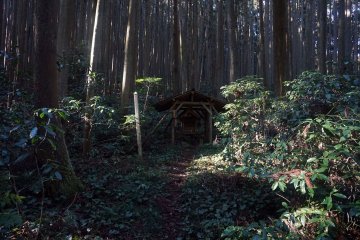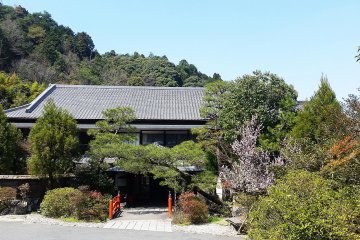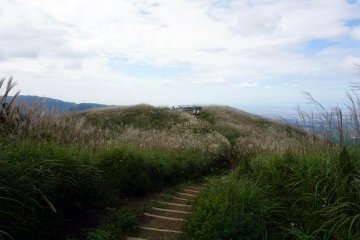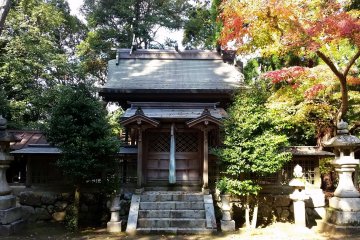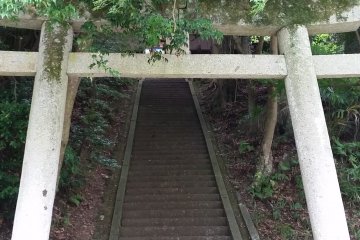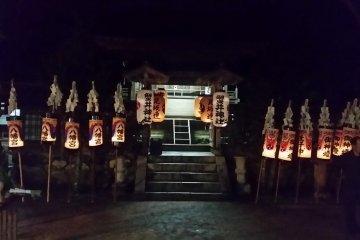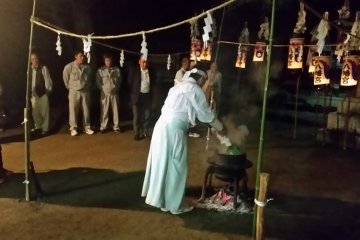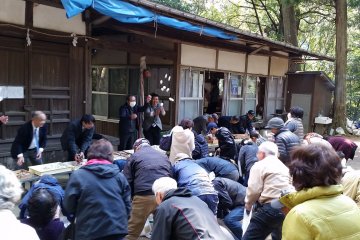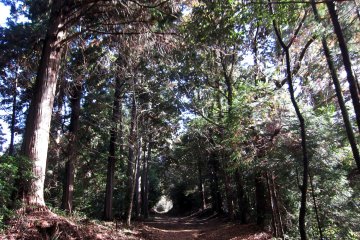Kanii-jinja is a very small Shinto shrine in the village of Amami in southern Osaka. Despite its size, it has a significant history dating back over 2,000 years.
To learn its story, we have to go back to the dawn of civilization in Japan and the saga of Jimmu-Tenno, the first Emperor.

The Tales
After landing his fleet on the coast of what would become Osaka Prefecture, he attempted to enter the plains of Yamato by crossing the mountains that separate Osaka and Nara Prefectures. However; as he was attacking in the direction of the sun, he offended his ancestor Amaterasu, the Sun Goddess. Blinded, his army was easily defeated by the barbarians.
Reeling from this defeat, and with his brother wounded by a poisoned arrow, the Emperor ordered his forces to march south, stopping several times as his brother’s condition worsened. One of the places they are thought to have made camp was an isolated, wooded hillside on the border of Osaka and Wakayama Prefectures, on the site where Kanii-jinja stands today.

From here, they made their way around the Izu Peninsula on foot and by boat before attacking the barbarians from the east. This time, with the sun at their back and Amaterasu on their side, they won a crushing victory and established the first Empire of Japan with a palace at Kashihara.
Kanii-jinja’s name translates as “Crab Shrine” which might seem unusual for somewhere so far inland. However; there are numerous small freshwater crabs that live in the waterways of Amami. At one point in history, a particularly impressive specimen was found in a brook near the shrine and presented to the Emperor (though which Emperor I cannot say).
The Shrine
The Shrine itself was founded several hundred years later and dedicated to Emperor Jimmu. While not quite so isolated now, it still retains an air of mystery and timelessness.

It sits on the side of a small hill directly over a section of the Nankai Koya Line, the railway line that links Namba with Mount Koya. The entrance can be easily missed as the stone torii gate is set back slightly from the narrow lane that winds up into the village of Shima-no-Tani.
The rough stone steps rise sharply passed a pair of Komainu guardian statues and through a gate into a small courtyard. The small shrine stands opposite the gate, surrounded by towering, ancient trees. Several of these trees are bound with shimenawa, sacred ropes made from rice straw. There are also several maple trees, making it a pretty, yet understated place to visit in Autumn.

A path out of the back of the shrine leads to a small glade that is sometimes used for forest bathing events. And if you look carefully, there is a difficult to spot trail that leads to another tiny shrine and extends off into the undergrowth.

Festivals
Kanii-jinja serves as the main shrine for the surrounding little villages that make up Amami and is the focal point for several unusual, rural festivals throughout the year. The first, held on April 3rd (the date of Emperor Jimmu’s death) is a Mochimaki, or rice cake throwing festival.

The village elders and their invited guests throw armfuls of small mochi rice cakes into the waiting crowd. Everyone tries to catch or scoop up as many as they can to take home and eat. If you are lucky, you might also pick up a few with numbers which you can take to an official to claim some simple prizes.
The second, a harvest festival, takes place in October. This is a Chochin Mairi which is a type of lantern procession. From starting points within the three villages, men carrying paper lanterns on heavy wooden poles slowly converge on the shrine.
As they walk, they sing an ancient song in an Ise Ondo style; a kind of call and answer chant. The leader of each group sings a line followed by the rest of the group singing a chorus line.

Once at the shrine, they line their lanterns up while the Shinto priest begins to make prayers and offerings to the enshrined spirit of Emperor Jimmu. He then turns his attention to a large pot of boiling water bubbling away in a section protected by sacred branches placed into the ground.
To this water he ritually adds salt, water and rice then thrusts two tamagushi, sacred sakaki tree branches, into the mixture. Then, quite without warning, he swings the tamagushi wildly overhead, showering the onlookers with hot sake and water. He dips them back in and swings them several times. Anyone who gets splashed is thought to be granted good luck for the rest of the year. The festival ends with everyone being given a cup of the sacred liquid to drink.

The final festival involves a Mikoshi, a heavy portable shrine, being carried around the villages on the shoulders of participants. Unfortunately, under the current circumstances, and with the advancing age of many of the villagers, some of these traditions are now very much in danger. Of the Ise Ondo singers, only myself and two others are under 60 years old.
Kanii Shrine is a perfect example of the rich history and fantastic tales that can make seemingly insignificant rural shrines really come to life!





